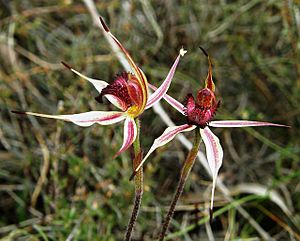Veined spider orchid facts for kids
Quick facts for kids Veined spider orchid |
|
|---|---|
 |
|
| Caladenia reticulata growing near the Grampians National Park | |
| Scientific classification | |
| Genus: |
Caladenia
|
| Species: |
reticulata
|
| Synonyms | |
|
|
The veined spider orchid (scientific name: Caladenia reticulata) is a special type of flower. It belongs to the orchid family, called Orchidaceae. This plant grows only in Victoria and South Australia in Australia. It's a ground orchid, meaning it grows in the soil. Each plant has one fuzzy leaf and usually just one flower. The flower is often yellowish-green and red.
Contents
What the Veined Spider Orchid Looks Like
The veined spider orchid is a plant that grows from the ground. It is a perennial plant, which means it lives for more than two years. It is also a deciduous plant, so it sheds its leaves at certain times. This plant is a herb, meaning it has soft stems, not woody ones like a tree.
Under the ground, it has a special part called a tuber. This tuber helps the plant store food. Each plant grows one hairy leaf. This leaf is about 70 to 120 millimeters (2.8 to 4.7 inches) long. It is also about 3 to 7 millimeters (0.1 to 0.3 inches) wide.
Usually, only one flower grows on each plant. The flower is yellowish-green and red, or sometimes completely red. It grows on a stem that is about 100 to 300 millimeters (3.9 to 11.8 inches) tall.
Flower Parts
The flower has parts called sepals. These sepals have dark, narrow, club-like tips. These tips are about 5 to 10 millimeters (0.2 to 0.4 inches) long.
- The top sepal, called the dorsal sepal, stands up straight at its base. Then it curves forward. It is about 20 to 30 millimeters (0.8 to 1.2 inches) long.
- The side sepals, called the lateral sepals, spread out. They are about 25 to 35 millimeters (1.0 to 1.4 inches) long and 4 to 5 millimeters (0.2 inches) wide.
- The petals are a bit shorter and narrower than the side sepals. They become very thin and thread-like at their ends.
The special lower petal is called the labellum. It is red or yellowish-green with red marks. The labellum is about 8 to 11 millimeters (0.3 to 0.4 inches) long and 6 to 8 millimeters (0.2 to 0.3 inches) wide. Sometimes, the sides of the labellum have small teeth. These teeth can be up to 1.3 millimeters (0.05 inches) long.
The labellum also has four or six rows of small bumps called calli. These calli are about 1.3 millimeters (0.05 inches) long near the base. They get smaller towards the tip of the labellum.
The veined spider orchid flowers from September to November.
How the Veined Spider Orchid Got Its Name
The scientific name for this orchid is Caladenia reticulata. It was first officially described in 1882. A person named Robert D. FitzGerald wrote about it. His description was published in a magazine called The Gardeners' Chronicle.
The second part of its name, reticulata, is a Latin word. It means "netted" or "net-like." This probably refers to the patterns on the flower.
Where the Veined Spider Orchid Lives
The veined spider orchid grows in many places, but it is not found everywhere in those areas. In Victoria, you can find it near towns like Stawell, Ararat, Horsham, and Dunolly. It usually grows in open woodlands.
In South Australia, this orchid grows in the Southern Lofty and Kangaroo Island areas. There, it prefers to grow on slopes that have forests.
Protecting the Veined Spider Orchid
The veined spider orchid is listed as "vulnerable" in Victoria. This means that its numbers are getting low. It could be at risk of disappearing if we don't protect it.

